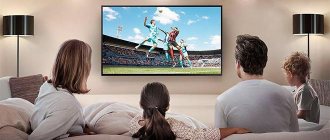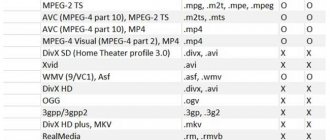Read what Ultra HD resolution means, how it differs from 4K and what the inscription on the new 4K Ultra HD LED TVs means.
In our fast-paced world, it is impossible to keep up with all the new technologies and developments. It seems that quite recently the ultimate dream was Full HD resolution for most devices, but today it is gradually being replaced by more modern and detailed 4K.
It brought not only a clearer picture, which TVs now show, but also confusion regarding one of the standards - UHD. In today’s article we will dot all the i’s by understanding all the formats and standards of the newfangled resolution.
What do we know about 4K?
Rumors around 4K began to actively gather in 2012, when the resolution began to slowly develop. It was interesting both to large companies for which it is important to constantly develop something new, and to ordinary users who want to constantly receive something new. LG did not stand aside, presenting the first 3D TV with 4K UHD at one of the 2012 exhibitions.
And other manufacturers who work with TVs and other multimedia devices tried to show something with 4K at such exhibitions.
Even then, one could talk about the imminent success of the new resolution, just looking at the admiring faces of visitors who froze in front of the ultra-high definition screens. But just 5 years ago, not everyone could afford a 4K TV. We had to wait a little.
4K resolution replaced the not so popular 2K, which followed Full HD. Most users, by the way, missed 2K due to the rapid appearance on the market of a more formidable competitor in the form of 4K. 2K today is increasingly used by some companies when developing displays for smartphones - models for those for whom Full HD is no longer enough on a mobile device.
The key difference between 4K and its predecessors, as you might guess, is greater resolution (a value that determines the number of dots (pixels) per unit area). So 4K exceeds 2K by approximately two times in width and height, and Full HD by 4 times. However, there is no single image resolution in pixels for 4K, so there are 6 standards. Among them are:
- Full frame 4K. The standard, which, in fact, reflects the 4K resolution in pixels - 4096 × 3072. However, it is not very common.
- Academic 4K. This standard is gaining wide popularity among film studios; ordinary users simply do not need it in their usual devices - 3656x2664 pixels.
- Cased 4K. Another type of cinema standard, which has a different aspect ratio. It has a similar resolution – 3996×2160 pixels.
- DCI 4K. Standard used in cameras. More and more modern smartphones support it, the resolution is 4096x2160 pixels.
- Widescreen 4K. Quite an interesting standard, but it will be interesting only to readers who are interested in filming films; the resolution is 4096 × 1716 pixels.
- Ultra HD. Finally, UHD, which is not only a variation of the 4K standards, but also an ultra-high-definition television standard. This is what we usually encounter when buying a new TV with an intriguing “4K” prefix. UHD resolution - 3840x2160 pixels.
Ultra HD is precisely what interests users due to its prevalence.
Colors and ranges: no need to buy obviously outdated ones
Last year, extended color range (aka HDR, High Dynamic Range Imaging) seemed like a fairy tale. But the improved colors were quickly appreciated by users and producers (Amazon and Netflix not only produce new films, but also digitize old films). Therefore, without HDR support, a new TV risks becoming obsolete in a couple of years - especially for games.
We must not forget about color display. Any matrix (or projector lamp/laser) reproduces standard 8-bit color. Sufficient for HD content. But in 4K on a large diagonal, such an image appears dim: too much of the screen area remains black. Gray transitions on 8 bits are invisible.
And this applies to all natural color gradations. For a high-quality image, you need 10-bit color - like in professional monitors for designers’ work. Requires HDR10 support. So far there are few such recordings, but this format is becoming the main one thanks to the active distribution of Apple and Sony recordings.
By the way, you won’t be able to view a file in HDR10 on a primitive TV - the colors will be incorrect and artifacts will appear. The conversion will take a long time. Either buy a TV with HDR support for growth, or stick with FullHD .
What is the difference between Ultra HD and 4K?
In fact, everything is very simple. 4K is the professional production standard, and Ultra HD is the standard for consumer displays and ultra-high definition television. In general, the term “4K” appeared thanks to the digital cinema consortium DCI (Digital Cinema Initiatives), which standardizes resolutions.
It is logical that this designation was attached due to the ratio of 4096 × 3072 pixels, which is 4 times larger than Full HD, which some call 1K resolution.
If you raise your eyes a little higher, you will understand that UHD does not fit the definition of 4K at all, since with its 3840x2160 pixels it does not reach the resolution. So why do manufacturers of televisions, TV boxes and other multimedia equipment often use “4K Ultra HD” in the name?
It's all about marketing. Thanks to the use of the term “4K” in the name, almost any TV will sell much better – the resolution is more popular than ever. Most often, companies use the designation “4K UHD” or “4K Ultra HD” so as not to violate the standard adopted by the DCI.
Still, you shouldn’t be upset that manufacturers offer you TVs with “incomplete” 4K. The difference in pixels is not that huge, especially since a number of additional parameters affect the picture quality. 4K and Ultra HD, despite their differences on paper, are today considered one and the same.
The real benefits of 4K
UltraHD, or 4K, really makes the difference.
No matter what anyone says, but with a normal TV, such a resolution on screens larger than 40 inches justifies itself in our small apartments. A high-quality film is distinguished by its bright colors, pleasant color transitions, precision and smooth movements. Is this not enough? Then you can move closer and play one of the most modern games. Dust and shadows are more lifelike in 4K than before.
But the coolest thing is high-quality digitization of analog recordings. Like alive. This is where even parents stop grumbling: “The Irony of Fate used to be livelier than it is now.” After all, in general, they are right. And only 4K helps to cope with the effect of “colorized cinema”.
And with a 4K display, you can buy TVs of absolutely incredible sizes. The thing is that on a 65-75-inch screen the corresponding video file looks like FullHD. This means that from a distance of a couple of meters - no squares.
Next time I will buy a panel that is at least 70 inches. And I advise you.
Although there are other advantages. Let's go in order.
4K Ultra HD as an ultra-high definition television standard
Do not miss:
- 4K resolution – is it needed on a TV and how many pixels are it?
- Let's understand what Smart TV is: history and popular systems
- How to painlessly survive the transition to digital television in Russia in 2021
In addition to the use of Ultra HD in technology, this standard is used in ultra-high definition television (Ultra High Definition Television or UHDTV). UHDTV is many times superior to standard and high definition television, being the most advanced standard today.
UHDTV, in addition to the 4K variety, includes another more advanced one - 8K (7680x4320). Only NHK managed to decompose an image with such a high resolution. For now, 8K remains only an ambitious project.
But 4K UHDTV has been used by many television operators for several years. Back in the summer of 2013, Russia launched the first public broadcast of UHDTV. However, the first channel in Russia with such permission began working only after a year and a half. Interest and popularity in ultra-high definition television is only growing, so a number of more channels are expected to be launched in the coming years.
Connection Tricolor 4K
In order to start watching ultra-high definition television, you need to connect new equipment. Then you need to configure it.
The setup algorithm includes the following steps.
- The satellite indicated is Eutelsat 36B.
- The search parameters are set - 12360 R SR 27500 and DVB-S2 8PSK FEC ¾.
- You need to log in to your account, activate and pay for the subscription. The price of an additional package of UltraHD channels is 1,500 rubles for 12 months, the main package is 2,500 for the same period.
- After paying and setting the receiver settings, you must leave the equipment turned on on an encrypted channel for about 8 hours to activate. After updating the activation codes, you should search for channels again to find new ones in UHD format.
Features 4K Ultra HD
In addition to the obviously larger number of pixels, Ultra HD resolution stands out from its predecessors in a number of other advantages. For example, the color range has been expanded from standard (SDR) to enhanced HDR. The result of the innovation was a more realistic and detailed image.
HDR technology is constantly being improved by different companies, so every year TVs are getting better at conveying the depth and contrast of a real picture.
Work is also underway on new quality standards, among which “UHD Premium” and “Dolby Vision” stand out. The first of them is already quite widespread, used by many manufacturers who strive to come to a consensus on what the ideal picture should look like.
Dolby Vision is still poorly distributed and is found only in very expensive TVs. This technology focuses on 12-bit color depth and a significant increase in brightness.
Another feature of 4K UHD is the increase in the number of frames per second to 60. This became possible thanks to the new version of HDMI 2.0, which replaced the previous one - 1.4, which appeared back in 2009. And the latest models of TVs and set-top boxes even receive HDMI 2.0a, which allows you to play content using HDR technology.
UHD TVs and set-top boxes can, of course, work with previous resolutions. For a long time, users believed that HD or Full HD content significantly loses quality when played on 4K devices. Naturally, this is not true, and the technologies used in modern devices can, on the contrary, improve video quality.
TVs and TV Boxes supporting 4K Ultra HD
You don’t have to be an electronics expert to not notice how leaps and bounds 4K UHD is making in the modern market. In a couple of years, this resolution managed to surpass its predecessors, relegating LED TVs and TV Boxes with Full HD, and even more so with HD, to the background.
And if just a couple of years ago there was a minimum of content for the new resolution (only in 2012 they presented the first film in 4K), today, with the cheaper cost of all Ultra HD technology, new videos, films and games appear almost every day.
Therefore, buying TVs with 4K today is already perceived as a smart purchase for the future, which will not become outdated in the next couple of years.
Android TV set-top boxes are even more popular, as they allow you to comfortably play 4K content. It is clear that they are bought, as a rule, for UHD TVs (which did not receive Smart TV or the user did not like the way the manufacturer implemented it).
However, some people purchase such set-top boxes, taking into account the further purchase of the corresponding TV. In addition, a TV Box UHD will cost about 3,000 rubles.
Prices for 4K Ultra HD TVs start from 30,000-35,000 rubles, which is relatively inexpensive, remembering the exorbitant price tags of 5 years ago. Definitely, if you have the desire and the means, then it’s worth considering, even if not the newest and “sophisticated” ones, but models with a new resolution.
Necessary equipment Tricolor
It was mentioned above that watching UHD content requires a suitable TV. In addition, users need to pay for a Tricolor TV subscription with 4K support. There may be 2 options here: connecting the main package Unified UHD or an additional package of 4K channels if “Unified” is already activated.
You should also buy the appropriate equipment:
- receiver GS B528;
- receiver GS A230;
- conditional access module CI+ CAM.
Along with the equipment, the user is provided with a smart card with UHD . If the subscriber has old equipment, he needs to buy new one or change the existing one. The provider regularly holds exchange promotions that help you purchase a new receiver or CI+ access module cheaper.
Important! If you exchange equipment or purchase a new one, you need to replace the smart card with a new one with UHD support. This point should be taken into account, since the access information is encrypted in the card, and even if you have a 4K receiver, you will not be able to watch channels in maximum resolution with the old card.
Bottom line
So, let’s consolidate the material of today’s article. Ultra HD is just a 4K standard used in consumer technology. It falls a little short of full-frame 4K, the characteristics of which are described in the relevant standards, although it does not cease to be a qualitatively new resolution with high detail.
The only noticeable difference was the resolution. We hope that now, when approaching a counter with TVs or other equipment, you won’t have to rack your brains with prefixes in the name, understanding the differences between 4K and Ultra HD.
Should you buy a cheap 4K TV?
Yes, if you find a model with a good image that meets all the above conditions. In the process of choosing mine, I came across 4K TVs
- to which you cannot connect a single source via HDMI - only via Wi-Fi 2.4 GHz
- with RWGB with excellent images and problems playing UltraHD through external inputs (without its own processing)
- on proprietary operating systems - without streaming services, or without support for playing files from the network
- with slow processors and terrible lags during playback
In any combination. Be careful when choosing. And think through the whole system: understanding what, where and what to look through allows you to save a lot of money.
(
86 votes, overall rating: 4.15 out of 5)










